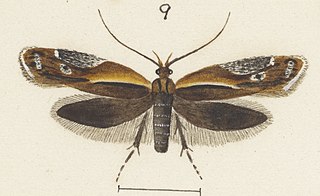
Schrankia costaestrigalis, the pinion-streaked snout, is a species of moth of the family Erebidae. It is found in Europe, the Canaries, Madeira, Syria, Armenia. It is also present in New Zealand. The species closely resembles Crambidae or Pyralidae species.
Aroga elaboratella is a moth of the family Gelechiidae. It is found in North America, where it has been recorded from California and Baja California.
Ardozyga odorifera is a species of moth in the family Gelechiidae. It was described by Edward Meyrick in 1904. It is found in Australia, where it has been recorded from New South Wales and Queensland.
Ardozyga furcifera is a species of moth in the family Gelechiidae. It was described by Turner in 1919. It is found in Australia, where it has been recorded from Victoria.
Telphusa smaragdopis is a moth of the family Gelechiidae. It is found in Costa Rica.
Commatica lupata is a moth in the family Gelechiidae. It was described by Edward Meyrick in 1914. It is found in Guyana and Peru.
Battaristis ichnota is a moth of the family Gelechiidae. It was described by Edward Meyrick in 1914. It is found in Guyana.
Stenoma bryocosma is a moth of the family Depressariidae. It is found in French Guiana and Brazil.
Cerconota flexibilis is a moth of the family Depressariidae. It is found in French Guiana.
Pilostibes basivitta is a moth in the family Xyloryctidae. It was described by Francis Walker in 1864. It is found in Australia, where it has been recorded from New South Wales and Queensland.
Eutorna eurygramma is a moth in the family Depressariidae. It was described by Edward Meyrick in 1906. It is found in Australia, where it has been recorded from Victoria, New South Wales and Tasmania.
Eutorna intonsa is a moth in the family Depressariidae. It was described by Edward Meyrick in 1906. It is found in Australia, where it has been recorded from Victoria, New South Wales and Tasmania.
Eutorna leptographa is a moth in the family Depressariidae. It was described by Edward Meyrick in 1906. It is found in Australia, where it has been recorded from Tasmania.
Eutorna pabulicola is a moth in the family Depressariidae. It was described by Edward Meyrick in 1906. It is found in Australia, where it has been recorded from Queensland and New South Wales.
Eutorna spintherias is a moth in the family Depressariidae. It was described by Edward Meyrick in 1906. It is found in Australia, where it has been recorded from Victoria and Tasmania.

Eutorna caryochroa is a species of moth in the family Depressariidae. It was described by Edward Meyrick in 1889 and is endemic to New Zealand. This species is found in both the North and South Islands. The larvae of this species are leaf miners and prefer damp grassland habitat. The adults are on the wing in December and January. They are day flying moths, they frequent forest and scrub, and have a habit of basking on leaves in the sunshine. They have been collected by beating shrubbery.
Eutorna generalis is a moth in the family Depressariidae. It was described by Edward Meyrick in 1921. It is found on Java and in Australia.
Eutorna insidiosa is a moth in the family Depressariidae. It was described by Edward Meyrick in 1910. It is found in India (Assam).
Psittacastis pictrix is a moth in the family Depressariidae. It was described by Edward Meyrick in 1921. It is found in Colombia.
Antaeotricha sortifera is a moth in the family Depressariidae. It was described by Edward Meyrick in 1930. It is found in Bolivia.



